A Comprehensive Literature Review of Cross Cultural Management
VerifiedAdded on 2021/05/31
|8
|2743
|64
Literature Review
AI Summary
This literature review explores the evolution and significance of cross cultural management and leadership in the global market. It discusses the relationship between culture and business operations, highlighting the importance of cultural awareness and effective communication. The review covers key concepts such as Hofstede's cultural dimensions model, addressing issues like language barriers and discrimination. It emphasizes the role of global leadership competencies, including social intelligence and conflict management, in fostering a positive working environment. The analysis concludes that cross cultural management is crucial for organizational success, requiring leaders to encourage creativity and motivation through flexible leadership approaches. Desklib offers this assignment and many more resources for students.
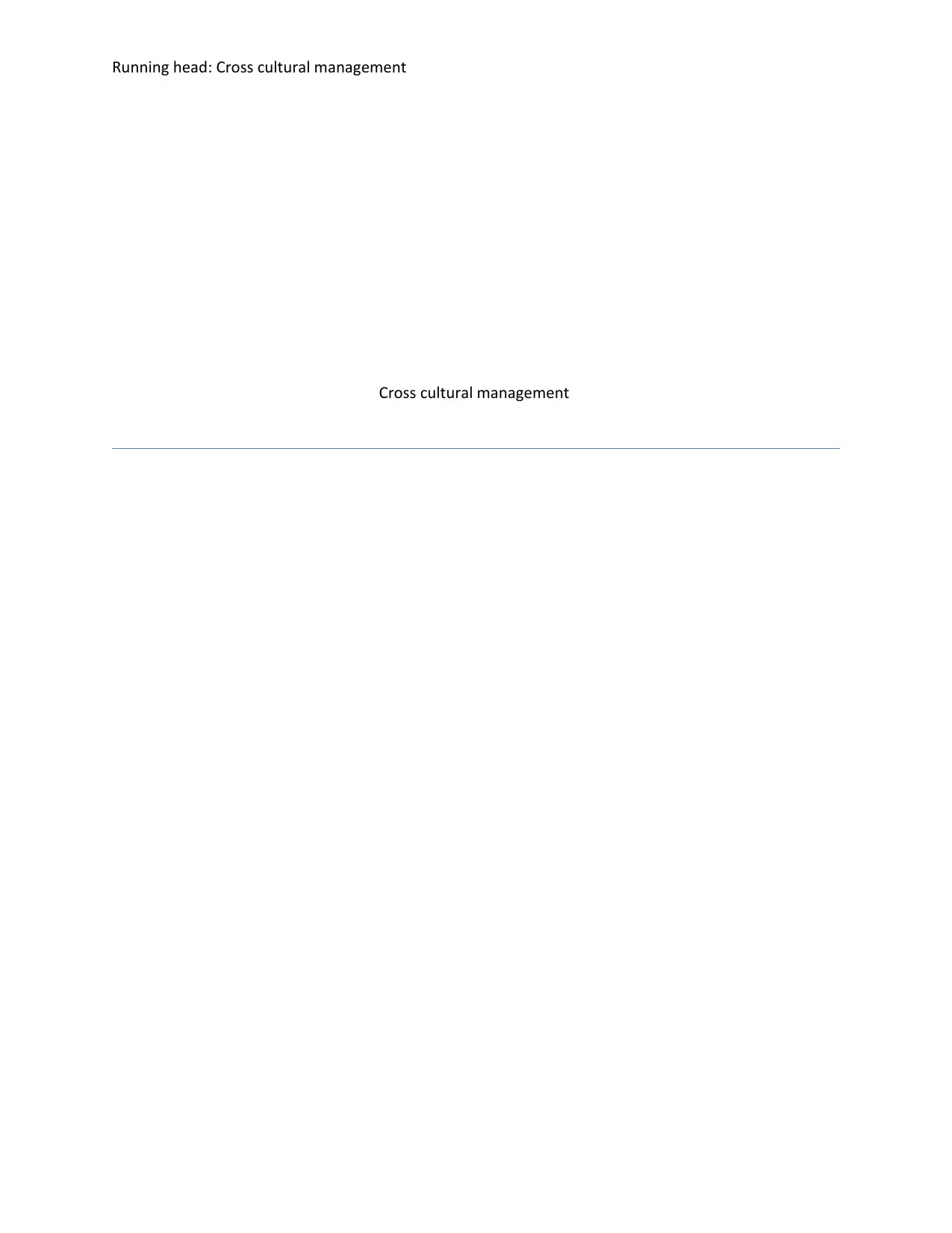
Running head: Cross cultural management
Cross cultural management
Cross cultural management
Paraphrase This Document
Need a fresh take? Get an instant paraphrase of this document with our AI Paraphraser
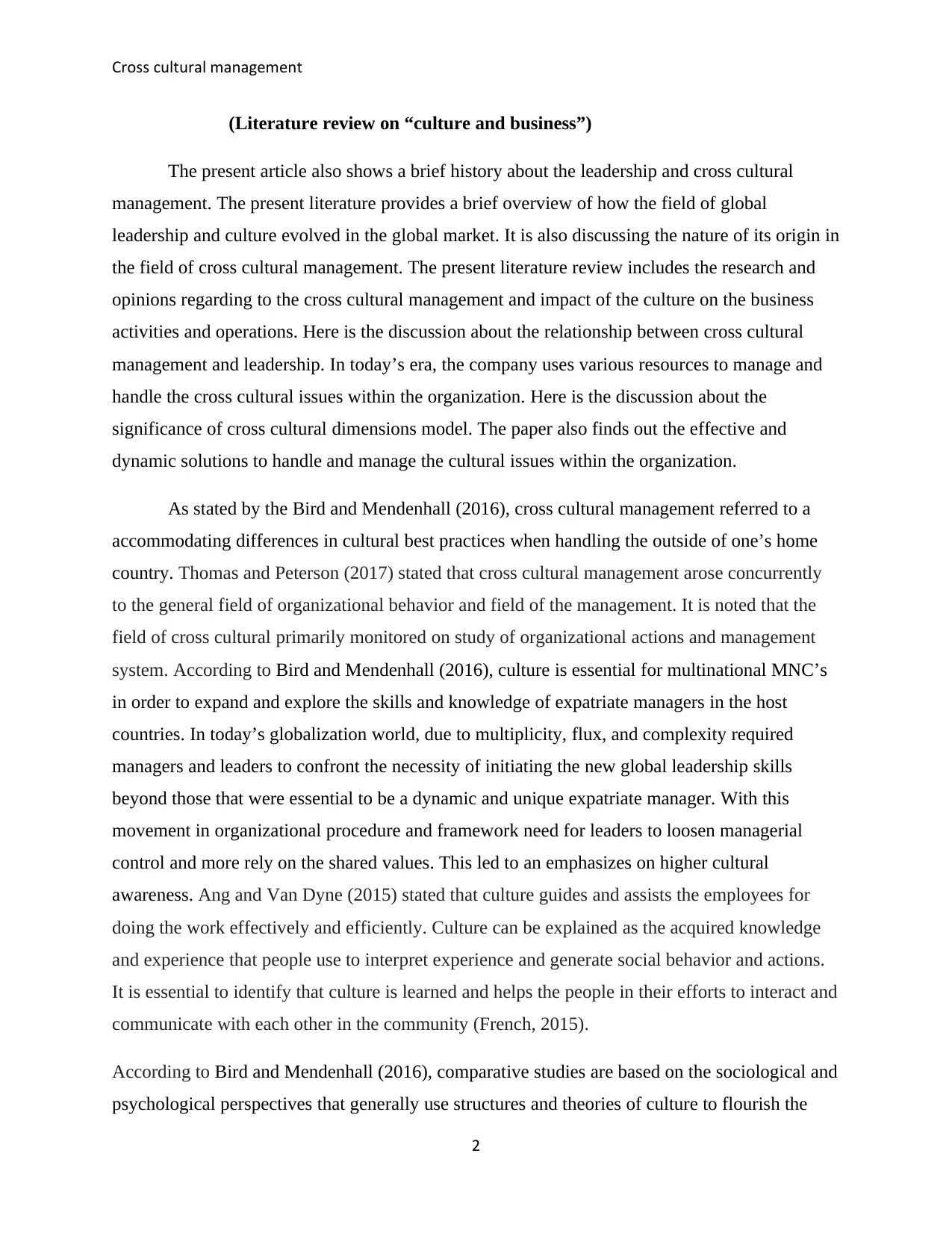
Cross cultural management
(Literature review on “culture and business”)
The present article also shows a brief history about the leadership and cross cultural
management. The present literature provides a brief overview of how the field of global
leadership and culture evolved in the global market. It is also discussing the nature of its origin in
the field of cross cultural management. The present literature review includes the research and
opinions regarding to the cross cultural management and impact of the culture on the business
activities and operations. Here is the discussion about the relationship between cross cultural
management and leadership. In today’s era, the company uses various resources to manage and
handle the cross cultural issues within the organization. Here is the discussion about the
significance of cross cultural dimensions model. The paper also finds out the effective and
dynamic solutions to handle and manage the cultural issues within the organization.
As stated by the Bird and Mendenhall (2016), cross cultural management referred to a
accommodating differences in cultural best practices when handling the outside of one’s home
country. Thomas and Peterson (2017) stated that cross cultural management arose concurrently
to the general field of organizational behavior and field of the management. It is noted that the
field of cross cultural primarily monitored on study of organizational actions and management
system. According to Bird and Mendenhall (2016), culture is essential for multinational MNC’s
in order to expand and explore the skills and knowledge of expatriate managers in the host
countries. In today’s globalization world, due to multiplicity, flux, and complexity required
managers and leaders to confront the necessity of initiating the new global leadership skills
beyond those that were essential to be a dynamic and unique expatriate manager. With this
movement in organizational procedure and framework need for leaders to loosen managerial
control and more rely on the shared values. This led to an emphasizes on higher cultural
awareness. Ang and Van Dyne (2015) stated that culture guides and assists the employees for
doing the work effectively and efficiently. Culture can be explained as the acquired knowledge
and experience that people use to interpret experience and generate social behavior and actions.
It is essential to identify that culture is learned and helps the people in their efforts to interact and
communicate with each other in the community (French, 2015).
According to Bird and Mendenhall (2016), comparative studies are based on the sociological and
psychological perspectives that generally use structures and theories of culture to flourish the
2
(Literature review on “culture and business”)
The present article also shows a brief history about the leadership and cross cultural
management. The present literature provides a brief overview of how the field of global
leadership and culture evolved in the global market. It is also discussing the nature of its origin in
the field of cross cultural management. The present literature review includes the research and
opinions regarding to the cross cultural management and impact of the culture on the business
activities and operations. Here is the discussion about the relationship between cross cultural
management and leadership. In today’s era, the company uses various resources to manage and
handle the cross cultural issues within the organization. Here is the discussion about the
significance of cross cultural dimensions model. The paper also finds out the effective and
dynamic solutions to handle and manage the cultural issues within the organization.
As stated by the Bird and Mendenhall (2016), cross cultural management referred to a
accommodating differences in cultural best practices when handling the outside of one’s home
country. Thomas and Peterson (2017) stated that cross cultural management arose concurrently
to the general field of organizational behavior and field of the management. It is noted that the
field of cross cultural primarily monitored on study of organizational actions and management
system. According to Bird and Mendenhall (2016), culture is essential for multinational MNC’s
in order to expand and explore the skills and knowledge of expatriate managers in the host
countries. In today’s globalization world, due to multiplicity, flux, and complexity required
managers and leaders to confront the necessity of initiating the new global leadership skills
beyond those that were essential to be a dynamic and unique expatriate manager. With this
movement in organizational procedure and framework need for leaders to loosen managerial
control and more rely on the shared values. This led to an emphasizes on higher cultural
awareness. Ang and Van Dyne (2015) stated that culture guides and assists the employees for
doing the work effectively and efficiently. Culture can be explained as the acquired knowledge
and experience that people use to interpret experience and generate social behavior and actions.
It is essential to identify that culture is learned and helps the people in their efforts to interact and
communicate with each other in the community (French, 2015).
According to Bird and Mendenhall (2016), comparative studies are based on the sociological and
psychological perspectives that generally use structures and theories of culture to flourish the
2
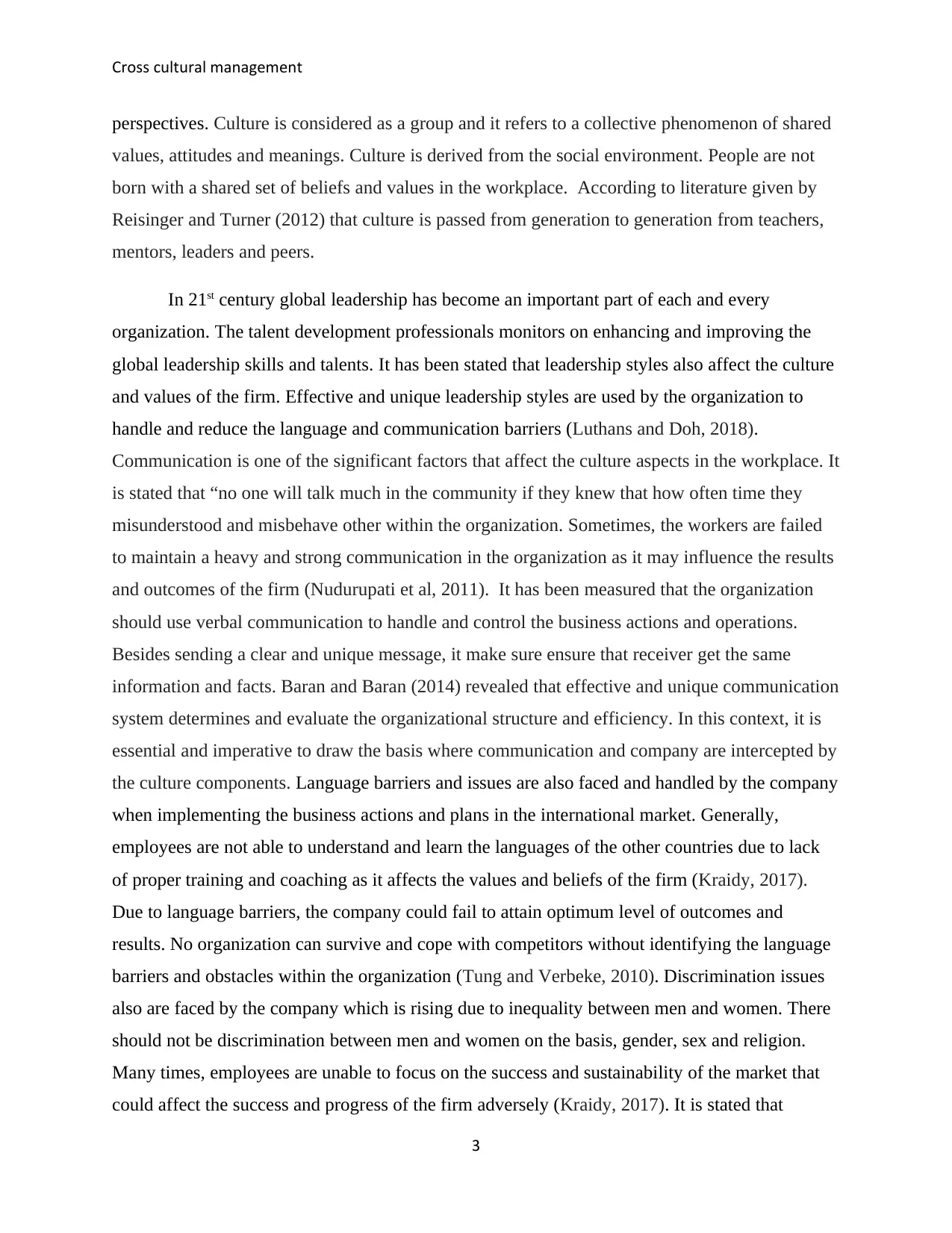
Cross cultural management
perspectives. Culture is considered as a group and it refers to a collective phenomenon of shared
values, attitudes and meanings. Culture is derived from the social environment. People are not
born with a shared set of beliefs and values in the workplace. According to literature given by
Reisinger and Turner (2012) that culture is passed from generation to generation from teachers,
mentors, leaders and peers.
In 21st century global leadership has become an important part of each and every
organization. The talent development professionals monitors on enhancing and improving the
global leadership skills and talents. It has been stated that leadership styles also affect the culture
and values of the firm. Effective and unique leadership styles are used by the organization to
handle and reduce the language and communication barriers (Luthans and Doh, 2018).
Communication is one of the significant factors that affect the culture aspects in the workplace. It
is stated that “no one will talk much in the community if they knew that how often time they
misunderstood and misbehave other within the organization. Sometimes, the workers are failed
to maintain a heavy and strong communication in the organization as it may influence the results
and outcomes of the firm (Nudurupati et al, 2011). It has been measured that the organization
should use verbal communication to handle and control the business actions and operations.
Besides sending a clear and unique message, it make sure ensure that receiver get the same
information and facts. Baran and Baran (2014) revealed that effective and unique communication
system determines and evaluate the organizational structure and efficiency. In this context, it is
essential and imperative to draw the basis where communication and company are intercepted by
the culture components. Language barriers and issues are also faced and handled by the company
when implementing the business actions and plans in the international market. Generally,
employees are not able to understand and learn the languages of the other countries due to lack
of proper training and coaching as it affects the values and beliefs of the firm (Kraidy, 2017).
Due to language barriers, the company could fail to attain optimum level of outcomes and
results. No organization can survive and cope with competitors without identifying the language
barriers and obstacles within the organization (Tung and Verbeke, 2010). Discrimination issues
also are faced by the company which is rising due to inequality between men and women. There
should not be discrimination between men and women on the basis, gender, sex and religion.
Many times, employees are unable to focus on the success and sustainability of the market that
could affect the success and progress of the firm adversely (Kraidy, 2017). It is stated that
3
perspectives. Culture is considered as a group and it refers to a collective phenomenon of shared
values, attitudes and meanings. Culture is derived from the social environment. People are not
born with a shared set of beliefs and values in the workplace. According to literature given by
Reisinger and Turner (2012) that culture is passed from generation to generation from teachers,
mentors, leaders and peers.
In 21st century global leadership has become an important part of each and every
organization. The talent development professionals monitors on enhancing and improving the
global leadership skills and talents. It has been stated that leadership styles also affect the culture
and values of the firm. Effective and unique leadership styles are used by the organization to
handle and reduce the language and communication barriers (Luthans and Doh, 2018).
Communication is one of the significant factors that affect the culture aspects in the workplace. It
is stated that “no one will talk much in the community if they knew that how often time they
misunderstood and misbehave other within the organization. Sometimes, the workers are failed
to maintain a heavy and strong communication in the organization as it may influence the results
and outcomes of the firm (Nudurupati et al, 2011). It has been measured that the organization
should use verbal communication to handle and control the business actions and operations.
Besides sending a clear and unique message, it make sure ensure that receiver get the same
information and facts. Baran and Baran (2014) revealed that effective and unique communication
system determines and evaluate the organizational structure and efficiency. In this context, it is
essential and imperative to draw the basis where communication and company are intercepted by
the culture components. Language barriers and issues are also faced and handled by the company
when implementing the business actions and plans in the international market. Generally,
employees are not able to understand and learn the languages of the other countries due to lack
of proper training and coaching as it affects the values and beliefs of the firm (Kraidy, 2017).
Due to language barriers, the company could fail to attain optimum level of outcomes and
results. No organization can survive and cope with competitors without identifying the language
barriers and obstacles within the organization (Tung and Verbeke, 2010). Discrimination issues
also are faced by the company which is rising due to inequality between men and women. There
should not be discrimination between men and women on the basis, gender, sex and religion.
Many times, employees are unable to focus on the success and sustainability of the market that
could affect the success and progress of the firm adversely (Kraidy, 2017). It is stated that
3
⊘ This is a preview!⊘
Do you want full access?
Subscribe today to unlock all pages.

Trusted by 1+ million students worldwide
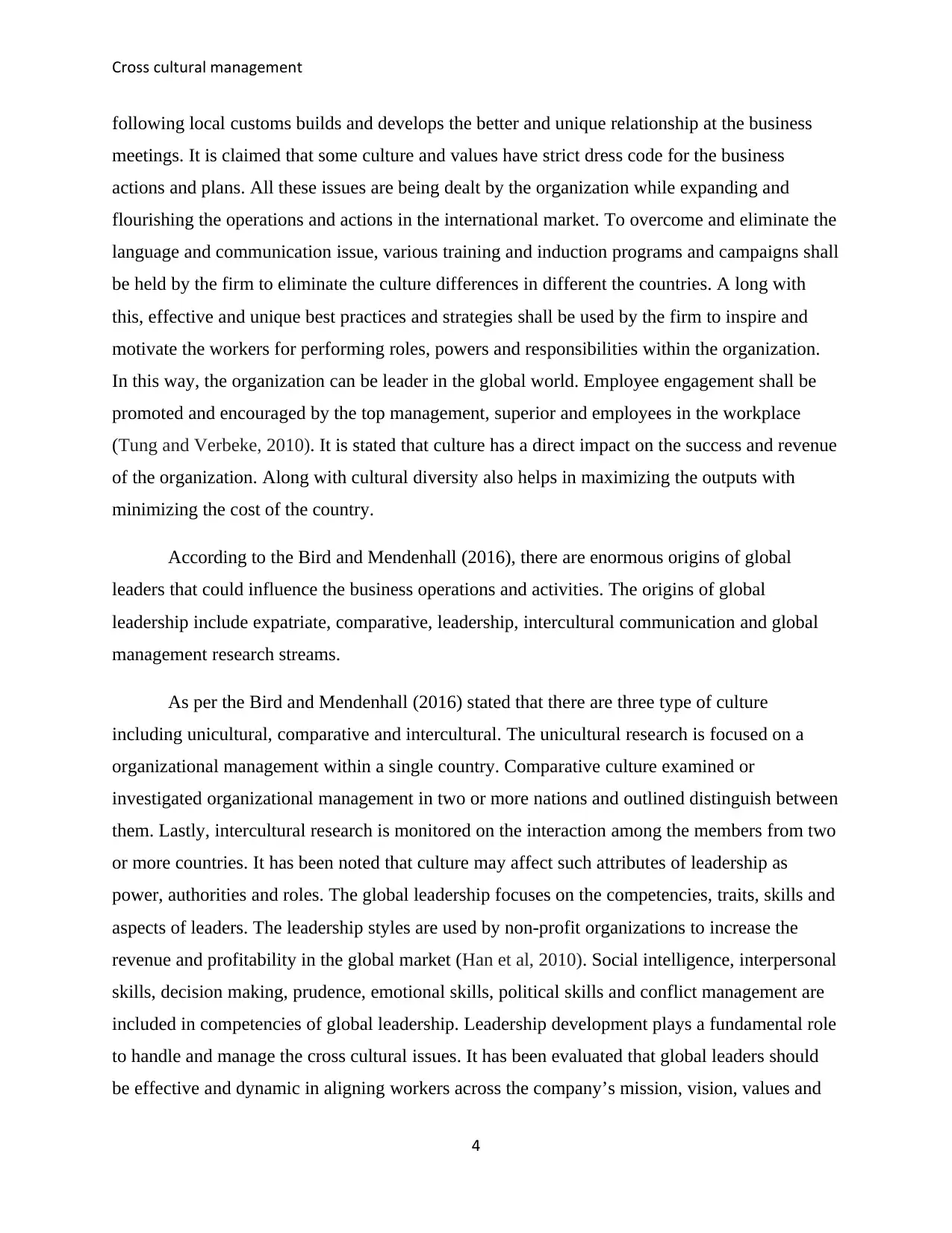
Cross cultural management
following local customs builds and develops the better and unique relationship at the business
meetings. It is claimed that some culture and values have strict dress code for the business
actions and plans. All these issues are being dealt by the organization while expanding and
flourishing the operations and actions in the international market. To overcome and eliminate the
language and communication issue, various training and induction programs and campaigns shall
be held by the firm to eliminate the culture differences in different the countries. A long with
this, effective and unique best practices and strategies shall be used by the firm to inspire and
motivate the workers for performing roles, powers and responsibilities within the organization.
In this way, the organization can be leader in the global world. Employee engagement shall be
promoted and encouraged by the top management, superior and employees in the workplace
(Tung and Verbeke, 2010). It is stated that culture has a direct impact on the success and revenue
of the organization. Along with cultural diversity also helps in maximizing the outputs with
minimizing the cost of the country.
According to the Bird and Mendenhall (2016), there are enormous origins of global
leaders that could influence the business operations and activities. The origins of global
leadership include expatriate, comparative, leadership, intercultural communication and global
management research streams.
As per the Bird and Mendenhall (2016) stated that there are three type of culture
including unicultural, comparative and intercultural. The unicultural research is focused on a
organizational management within a single country. Comparative culture examined or
investigated organizational management in two or more nations and outlined distinguish between
them. Lastly, intercultural research is monitored on the interaction among the members from two
or more countries. It has been noted that culture may affect such attributes of leadership as
power, authorities and roles. The global leadership focuses on the competencies, traits, skills and
aspects of leaders. The leadership styles are used by non-profit organizations to increase the
revenue and profitability in the global market (Han et al, 2010). Social intelligence, interpersonal
skills, decision making, prudence, emotional skills, political skills and conflict management are
included in competencies of global leadership. Leadership development plays a fundamental role
to handle and manage the cross cultural issues. It has been evaluated that global leaders should
be effective and dynamic in aligning workers across the company’s mission, vision, values and
4
following local customs builds and develops the better and unique relationship at the business
meetings. It is claimed that some culture and values have strict dress code for the business
actions and plans. All these issues are being dealt by the organization while expanding and
flourishing the operations and actions in the international market. To overcome and eliminate the
language and communication issue, various training and induction programs and campaigns shall
be held by the firm to eliminate the culture differences in different the countries. A long with
this, effective and unique best practices and strategies shall be used by the firm to inspire and
motivate the workers for performing roles, powers and responsibilities within the organization.
In this way, the organization can be leader in the global world. Employee engagement shall be
promoted and encouraged by the top management, superior and employees in the workplace
(Tung and Verbeke, 2010). It is stated that culture has a direct impact on the success and revenue
of the organization. Along with cultural diversity also helps in maximizing the outputs with
minimizing the cost of the country.
According to the Bird and Mendenhall (2016), there are enormous origins of global
leaders that could influence the business operations and activities. The origins of global
leadership include expatriate, comparative, leadership, intercultural communication and global
management research streams.
As per the Bird and Mendenhall (2016) stated that there are three type of culture
including unicultural, comparative and intercultural. The unicultural research is focused on a
organizational management within a single country. Comparative culture examined or
investigated organizational management in two or more nations and outlined distinguish between
them. Lastly, intercultural research is monitored on the interaction among the members from two
or more countries. It has been noted that culture may affect such attributes of leadership as
power, authorities and roles. The global leadership focuses on the competencies, traits, skills and
aspects of leaders. The leadership styles are used by non-profit organizations to increase the
revenue and profitability in the global market (Han et al, 2010). Social intelligence, interpersonal
skills, decision making, prudence, emotional skills, political skills and conflict management are
included in competencies of global leadership. Leadership development plays a fundamental role
to handle and manage the cross cultural issues. It has been evaluated that global leaders should
be effective and dynamic in aligning workers across the company’s mission, vision, values and
4
Paraphrase This Document
Need a fresh take? Get an instant paraphrase of this document with our AI Paraphraser
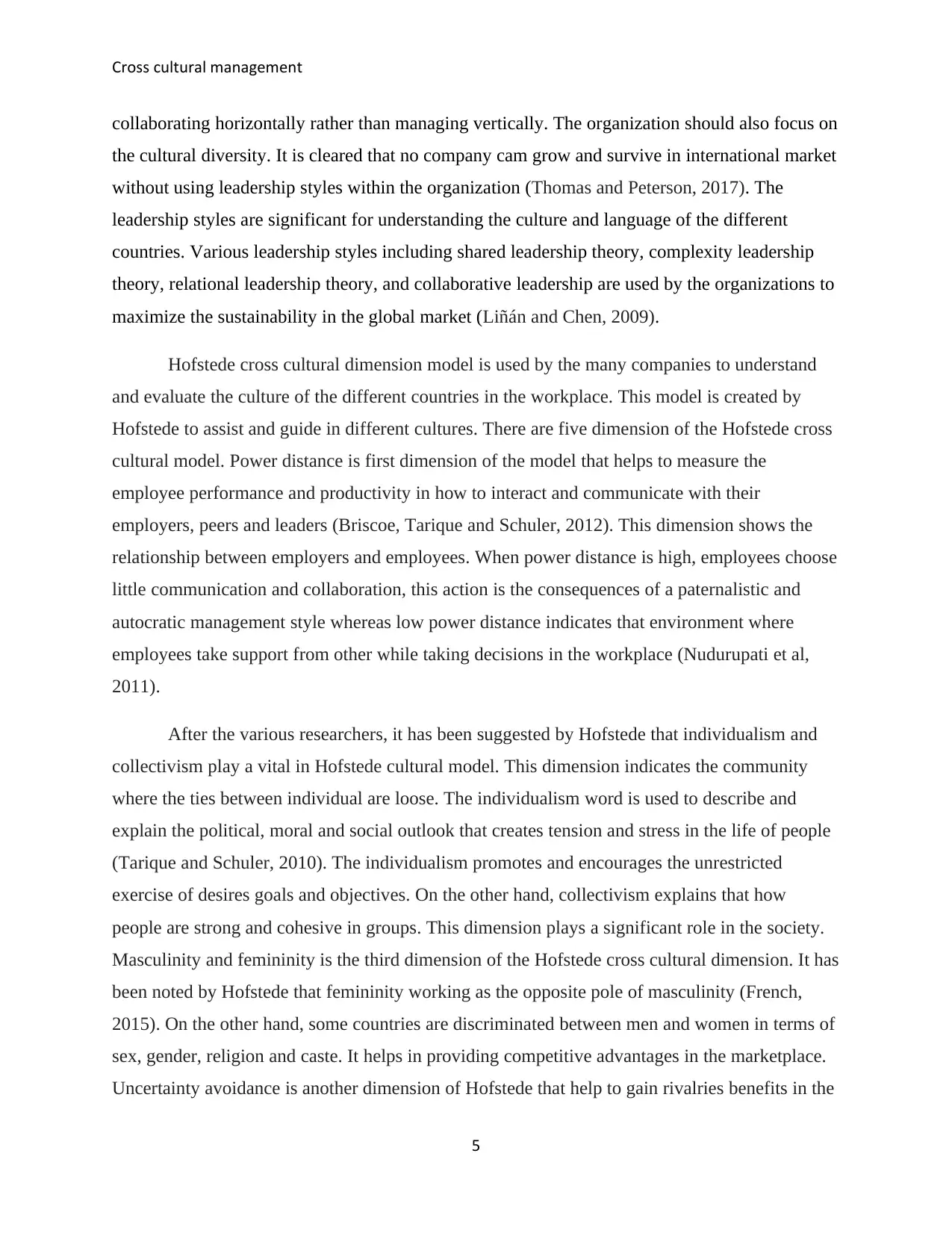
Cross cultural management
collaborating horizontally rather than managing vertically. The organization should also focus on
the cultural diversity. It is cleared that no company cam grow and survive in international market
without using leadership styles within the organization (Thomas and Peterson, 2017). The
leadership styles are significant for understanding the culture and language of the different
countries. Various leadership styles including shared leadership theory, complexity leadership
theory, relational leadership theory, and collaborative leadership are used by the organizations to
maximize the sustainability in the global market (Liñán and Chen, 2009).
Hofstede cross cultural dimension model is used by the many companies to understand
and evaluate the culture of the different countries in the workplace. This model is created by
Hofstede to assist and guide in different cultures. There are five dimension of the Hofstede cross
cultural model. Power distance is first dimension of the model that helps to measure the
employee performance and productivity in how to interact and communicate with their
employers, peers and leaders (Briscoe, Tarique and Schuler, 2012). This dimension shows the
relationship between employers and employees. When power distance is high, employees choose
little communication and collaboration, this action is the consequences of a paternalistic and
autocratic management style whereas low power distance indicates that environment where
employees take support from other while taking decisions in the workplace (Nudurupati et al,
2011).
After the various researchers, it has been suggested by Hofstede that individualism and
collectivism play a vital in Hofstede cultural model. This dimension indicates the community
where the ties between individual are loose. The individualism word is used to describe and
explain the political, moral and social outlook that creates tension and stress in the life of people
(Tarique and Schuler, 2010). The individualism promotes and encourages the unrestricted
exercise of desires goals and objectives. On the other hand, collectivism explains that how
people are strong and cohesive in groups. This dimension plays a significant role in the society.
Masculinity and femininity is the third dimension of the Hofstede cross cultural dimension. It has
been noted by Hofstede that femininity working as the opposite pole of masculinity (French,
2015). On the other hand, some countries are discriminated between men and women in terms of
sex, gender, religion and caste. It helps in providing competitive advantages in the marketplace.
Uncertainty avoidance is another dimension of Hofstede that help to gain rivalries benefits in the
5
collaborating horizontally rather than managing vertically. The organization should also focus on
the cultural diversity. It is cleared that no company cam grow and survive in international market
without using leadership styles within the organization (Thomas and Peterson, 2017). The
leadership styles are significant for understanding the culture and language of the different
countries. Various leadership styles including shared leadership theory, complexity leadership
theory, relational leadership theory, and collaborative leadership are used by the organizations to
maximize the sustainability in the global market (Liñán and Chen, 2009).
Hofstede cross cultural dimension model is used by the many companies to understand
and evaluate the culture of the different countries in the workplace. This model is created by
Hofstede to assist and guide in different cultures. There are five dimension of the Hofstede cross
cultural model. Power distance is first dimension of the model that helps to measure the
employee performance and productivity in how to interact and communicate with their
employers, peers and leaders (Briscoe, Tarique and Schuler, 2012). This dimension shows the
relationship between employers and employees. When power distance is high, employees choose
little communication and collaboration, this action is the consequences of a paternalistic and
autocratic management style whereas low power distance indicates that environment where
employees take support from other while taking decisions in the workplace (Nudurupati et al,
2011).
After the various researchers, it has been suggested by Hofstede that individualism and
collectivism play a vital in Hofstede cultural model. This dimension indicates the community
where the ties between individual are loose. The individualism word is used to describe and
explain the political, moral and social outlook that creates tension and stress in the life of people
(Tarique and Schuler, 2010). The individualism promotes and encourages the unrestricted
exercise of desires goals and objectives. On the other hand, collectivism explains that how
people are strong and cohesive in groups. This dimension plays a significant role in the society.
Masculinity and femininity is the third dimension of the Hofstede cross cultural dimension. It has
been noted by Hofstede that femininity working as the opposite pole of masculinity (French,
2015). On the other hand, some countries are discriminated between men and women in terms of
sex, gender, religion and caste. It helps in providing competitive advantages in the marketplace.
Uncertainty avoidance is another dimension of Hofstede that help to gain rivalries benefits in the
5
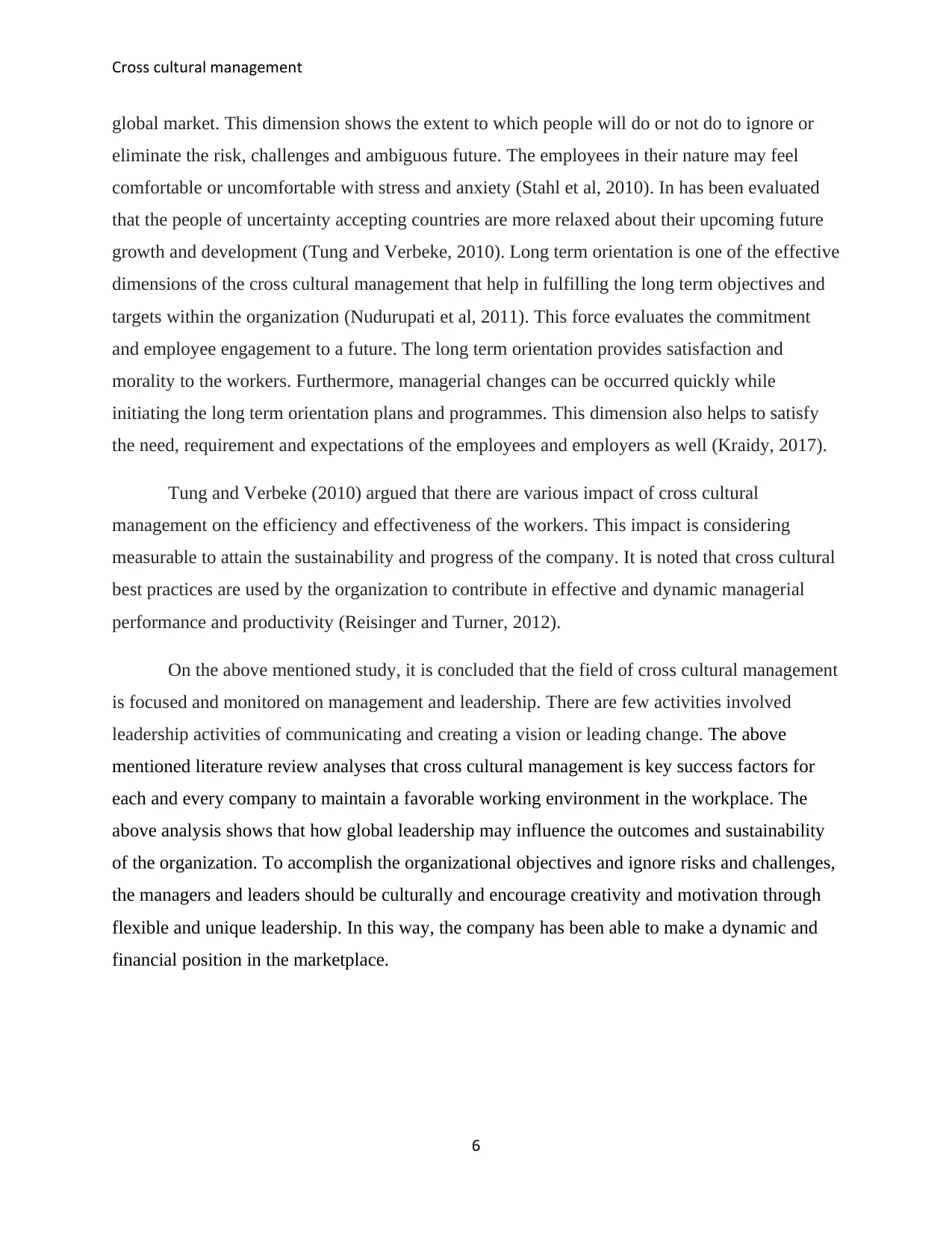
Cross cultural management
global market. This dimension shows the extent to which people will do or not do to ignore or
eliminate the risk, challenges and ambiguous future. The employees in their nature may feel
comfortable or uncomfortable with stress and anxiety (Stahl et al, 2010). In has been evaluated
that the people of uncertainty accepting countries are more relaxed about their upcoming future
growth and development (Tung and Verbeke, 2010). Long term orientation is one of the effective
dimensions of the cross cultural management that help in fulfilling the long term objectives and
targets within the organization (Nudurupati et al, 2011). This force evaluates the commitment
and employee engagement to a future. The long term orientation provides satisfaction and
morality to the workers. Furthermore, managerial changes can be occurred quickly while
initiating the long term orientation plans and programmes. This dimension also helps to satisfy
the need, requirement and expectations of the employees and employers as well (Kraidy, 2017).
Tung and Verbeke (2010) argued that there are various impact of cross cultural
management on the efficiency and effectiveness of the workers. This impact is considering
measurable to attain the sustainability and progress of the company. It is noted that cross cultural
best practices are used by the organization to contribute in effective and dynamic managerial
performance and productivity (Reisinger and Turner, 2012).
On the above mentioned study, it is concluded that the field of cross cultural management
is focused and monitored on management and leadership. There are few activities involved
leadership activities of communicating and creating a vision or leading change. The above
mentioned literature review analyses that cross cultural management is key success factors for
each and every company to maintain a favorable working environment in the workplace. The
above analysis shows that how global leadership may influence the outcomes and sustainability
of the organization. To accomplish the organizational objectives and ignore risks and challenges,
the managers and leaders should be culturally and encourage creativity and motivation through
flexible and unique leadership. In this way, the company has been able to make a dynamic and
financial position in the marketplace.
6
global market. This dimension shows the extent to which people will do or not do to ignore or
eliminate the risk, challenges and ambiguous future. The employees in their nature may feel
comfortable or uncomfortable with stress and anxiety (Stahl et al, 2010). In has been evaluated
that the people of uncertainty accepting countries are more relaxed about their upcoming future
growth and development (Tung and Verbeke, 2010). Long term orientation is one of the effective
dimensions of the cross cultural management that help in fulfilling the long term objectives and
targets within the organization (Nudurupati et al, 2011). This force evaluates the commitment
and employee engagement to a future. The long term orientation provides satisfaction and
morality to the workers. Furthermore, managerial changes can be occurred quickly while
initiating the long term orientation plans and programmes. This dimension also helps to satisfy
the need, requirement and expectations of the employees and employers as well (Kraidy, 2017).
Tung and Verbeke (2010) argued that there are various impact of cross cultural
management on the efficiency and effectiveness of the workers. This impact is considering
measurable to attain the sustainability and progress of the company. It is noted that cross cultural
best practices are used by the organization to contribute in effective and dynamic managerial
performance and productivity (Reisinger and Turner, 2012).
On the above mentioned study, it is concluded that the field of cross cultural management
is focused and monitored on management and leadership. There are few activities involved
leadership activities of communicating and creating a vision or leading change. The above
mentioned literature review analyses that cross cultural management is key success factors for
each and every company to maintain a favorable working environment in the workplace. The
above analysis shows that how global leadership may influence the outcomes and sustainability
of the organization. To accomplish the organizational objectives and ignore risks and challenges,
the managers and leaders should be culturally and encourage creativity and motivation through
flexible and unique leadership. In this way, the company has been able to make a dynamic and
financial position in the marketplace.
6
⊘ This is a preview!⊘
Do you want full access?
Subscribe today to unlock all pages.

Trusted by 1+ million students worldwide
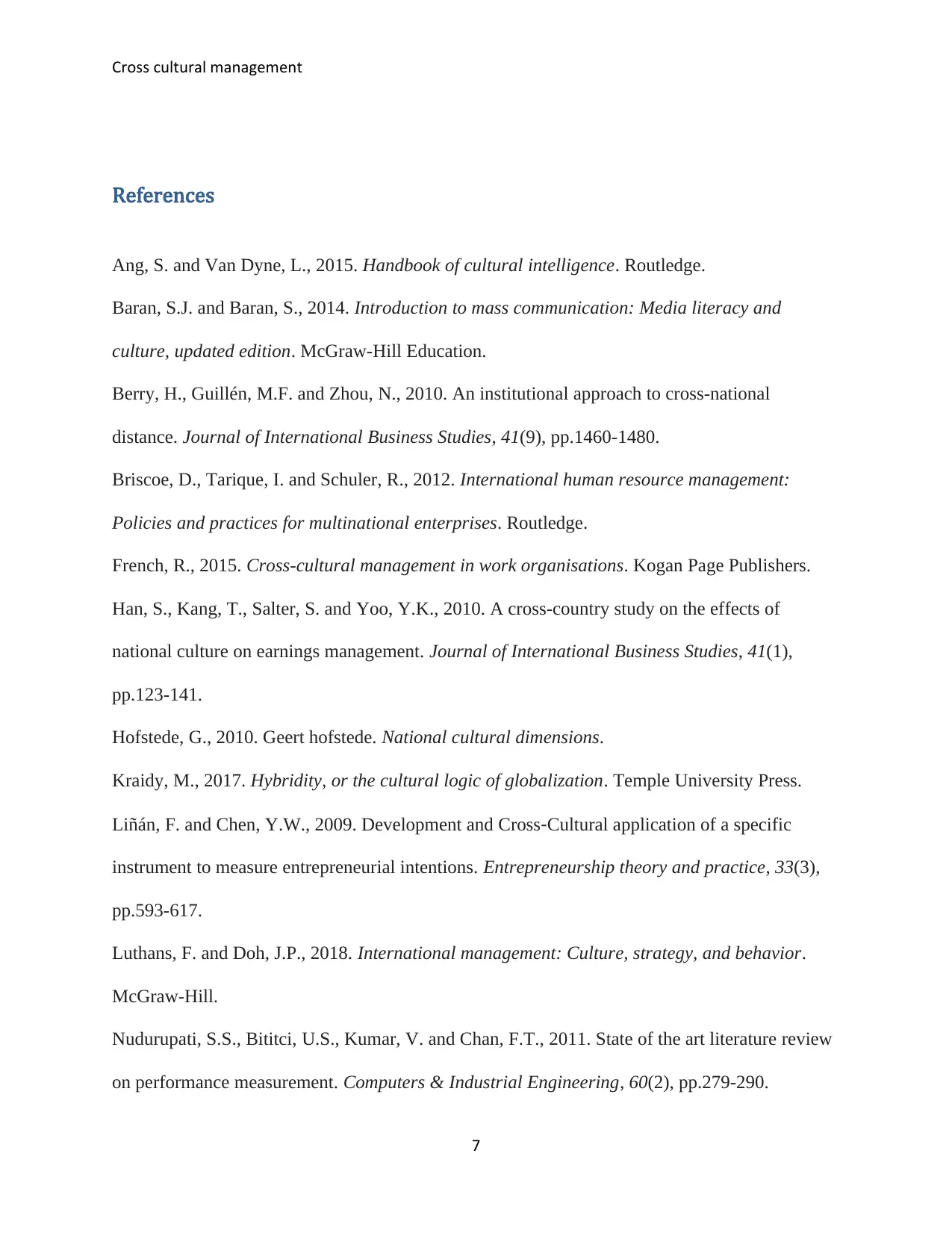
Cross cultural management
References
Ang, S. and Van Dyne, L., 2015. Handbook of cultural intelligence. Routledge.
Baran, S.J. and Baran, S., 2014. Introduction to mass communication: Media literacy and
culture, updated edition. McGraw-Hill Education.
Berry, H., Guillén, M.F. and Zhou, N., 2010. An institutional approach to cross-national
distance. Journal of International Business Studies, 41(9), pp.1460-1480.
Briscoe, D., Tarique, I. and Schuler, R., 2012. International human resource management:
Policies and practices for multinational enterprises. Routledge.
French, R., 2015. Cross-cultural management in work organisations. Kogan Page Publishers.
Han, S., Kang, T., Salter, S. and Yoo, Y.K., 2010. A cross-country study on the effects of
national culture on earnings management. Journal of International Business Studies, 41(1),
pp.123-141.
Hofstede, G., 2010. Geert hofstede. National cultural dimensions.
Kraidy, M., 2017. Hybridity, or the cultural logic of globalization. Temple University Press.
Liñán, F. and Chen, Y.W., 2009. Development and Cross‐Cultural application of a specific
instrument to measure entrepreneurial intentions. Entrepreneurship theory and practice, 33(3),
pp.593-617.
Luthans, F. and Doh, J.P., 2018. International management: Culture, strategy, and behavior.
McGraw-Hill.
Nudurupati, S.S., Bititci, U.S., Kumar, V. and Chan, F.T., 2011. State of the art literature review
on performance measurement. Computers & Industrial Engineering, 60(2), pp.279-290.
7
References
Ang, S. and Van Dyne, L., 2015. Handbook of cultural intelligence. Routledge.
Baran, S.J. and Baran, S., 2014. Introduction to mass communication: Media literacy and
culture, updated edition. McGraw-Hill Education.
Berry, H., Guillén, M.F. and Zhou, N., 2010. An institutional approach to cross-national
distance. Journal of International Business Studies, 41(9), pp.1460-1480.
Briscoe, D., Tarique, I. and Schuler, R., 2012. International human resource management:
Policies and practices for multinational enterprises. Routledge.
French, R., 2015. Cross-cultural management in work organisations. Kogan Page Publishers.
Han, S., Kang, T., Salter, S. and Yoo, Y.K., 2010. A cross-country study on the effects of
national culture on earnings management. Journal of International Business Studies, 41(1),
pp.123-141.
Hofstede, G., 2010. Geert hofstede. National cultural dimensions.
Kraidy, M., 2017. Hybridity, or the cultural logic of globalization. Temple University Press.
Liñán, F. and Chen, Y.W., 2009. Development and Cross‐Cultural application of a specific
instrument to measure entrepreneurial intentions. Entrepreneurship theory and practice, 33(3),
pp.593-617.
Luthans, F. and Doh, J.P., 2018. International management: Culture, strategy, and behavior.
McGraw-Hill.
Nudurupati, S.S., Bititci, U.S., Kumar, V. and Chan, F.T., 2011. State of the art literature review
on performance measurement. Computers & Industrial Engineering, 60(2), pp.279-290.
7
Paraphrase This Document
Need a fresh take? Get an instant paraphrase of this document with our AI Paraphraser
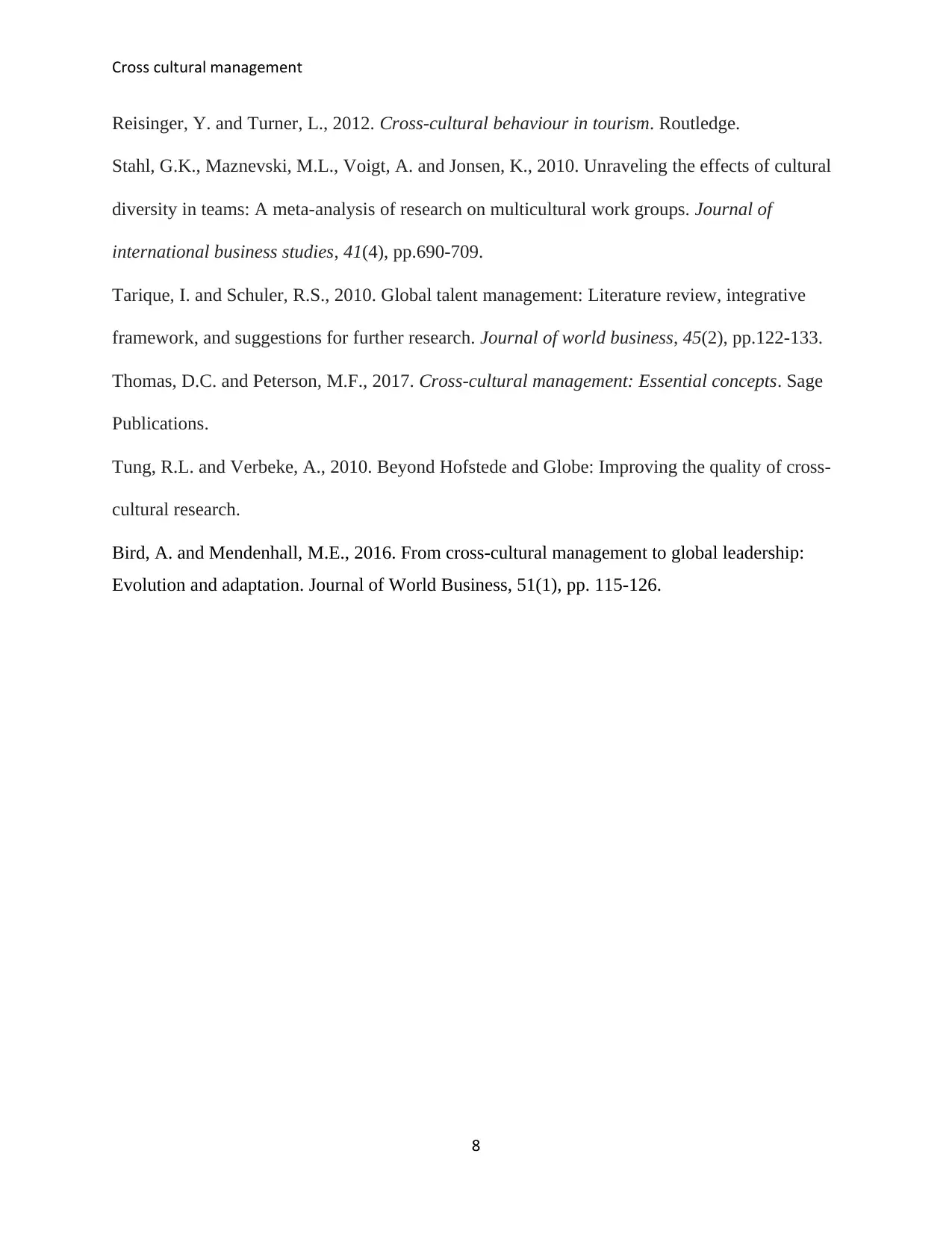
Cross cultural management
Reisinger, Y. and Turner, L., 2012. Cross-cultural behaviour in tourism. Routledge.
Stahl, G.K., Maznevski, M.L., Voigt, A. and Jonsen, K., 2010. Unraveling the effects of cultural
diversity in teams: A meta-analysis of research on multicultural work groups. Journal of
international business studies, 41(4), pp.690-709.
Tarique, I. and Schuler, R.S., 2010. Global talent management: Literature review, integrative
framework, and suggestions for further research. Journal of world business, 45(2), pp.122-133.
Thomas, D.C. and Peterson, M.F., 2017. Cross-cultural management: Essential concepts. Sage
Publications.
Tung, R.L. and Verbeke, A., 2010. Beyond Hofstede and Globe: Improving the quality of cross-
cultural research.
Bird, A. and Mendenhall, M.E., 2016. From cross-cultural management to global leadership:
Evolution and adaptation. Journal of World Business, 51(1), pp. 115-126.
8
Reisinger, Y. and Turner, L., 2012. Cross-cultural behaviour in tourism. Routledge.
Stahl, G.K., Maznevski, M.L., Voigt, A. and Jonsen, K., 2010. Unraveling the effects of cultural
diversity in teams: A meta-analysis of research on multicultural work groups. Journal of
international business studies, 41(4), pp.690-709.
Tarique, I. and Schuler, R.S., 2010. Global talent management: Literature review, integrative
framework, and suggestions for further research. Journal of world business, 45(2), pp.122-133.
Thomas, D.C. and Peterson, M.F., 2017. Cross-cultural management: Essential concepts. Sage
Publications.
Tung, R.L. and Verbeke, A., 2010. Beyond Hofstede and Globe: Improving the quality of cross-
cultural research.
Bird, A. and Mendenhall, M.E., 2016. From cross-cultural management to global leadership:
Evolution and adaptation. Journal of World Business, 51(1), pp. 115-126.
8
1 out of 8
Related Documents
Your All-in-One AI-Powered Toolkit for Academic Success.
+13062052269
info@desklib.com
Available 24*7 on WhatsApp / Email
![[object Object]](/_next/static/media/star-bottom.7253800d.svg)
Unlock your academic potential
Copyright © 2020–2025 A2Z Services. All Rights Reserved. Developed and managed by ZUCOL.





